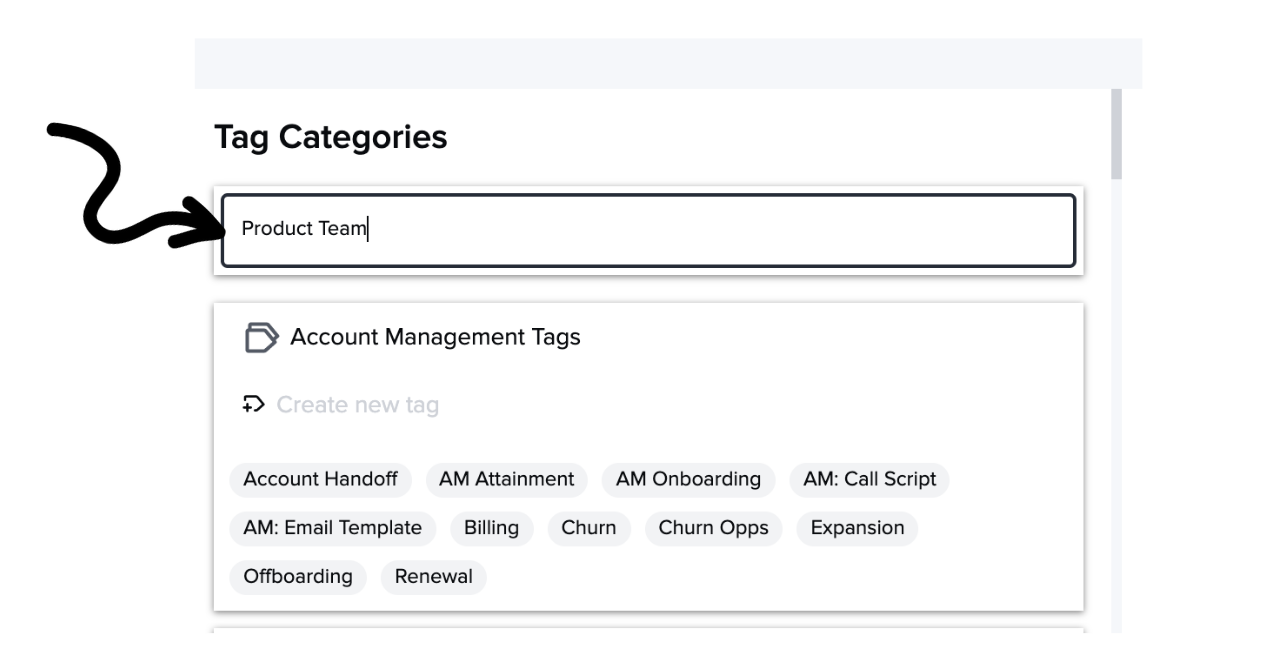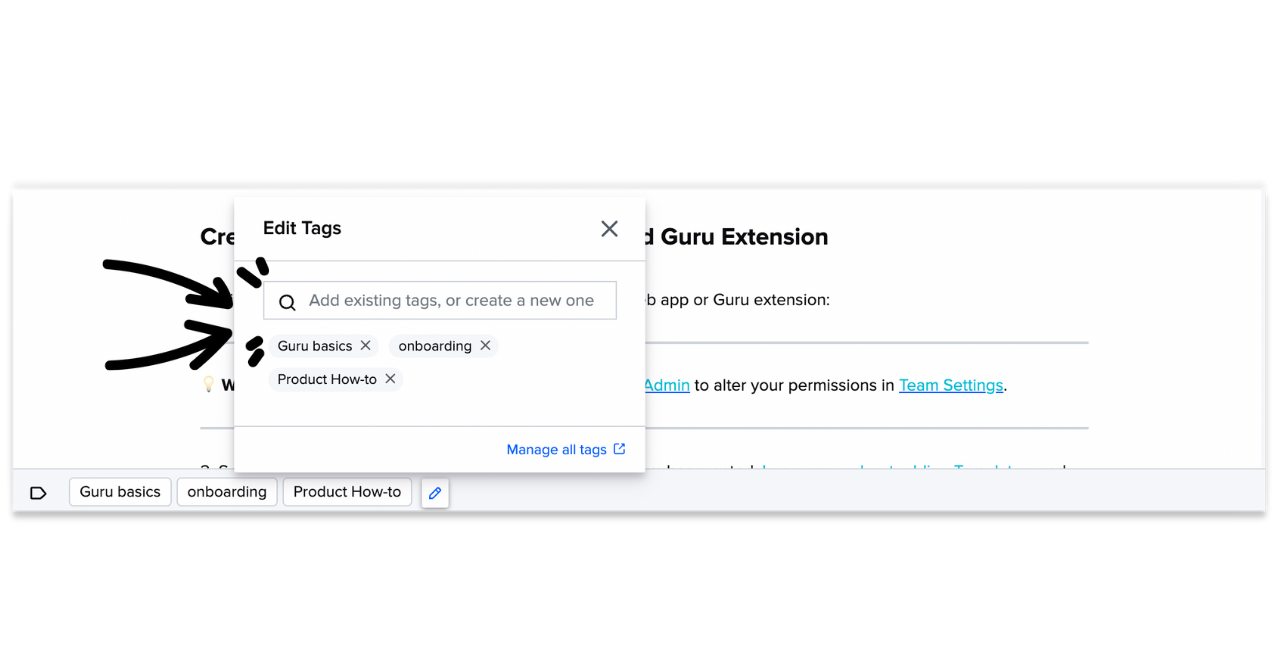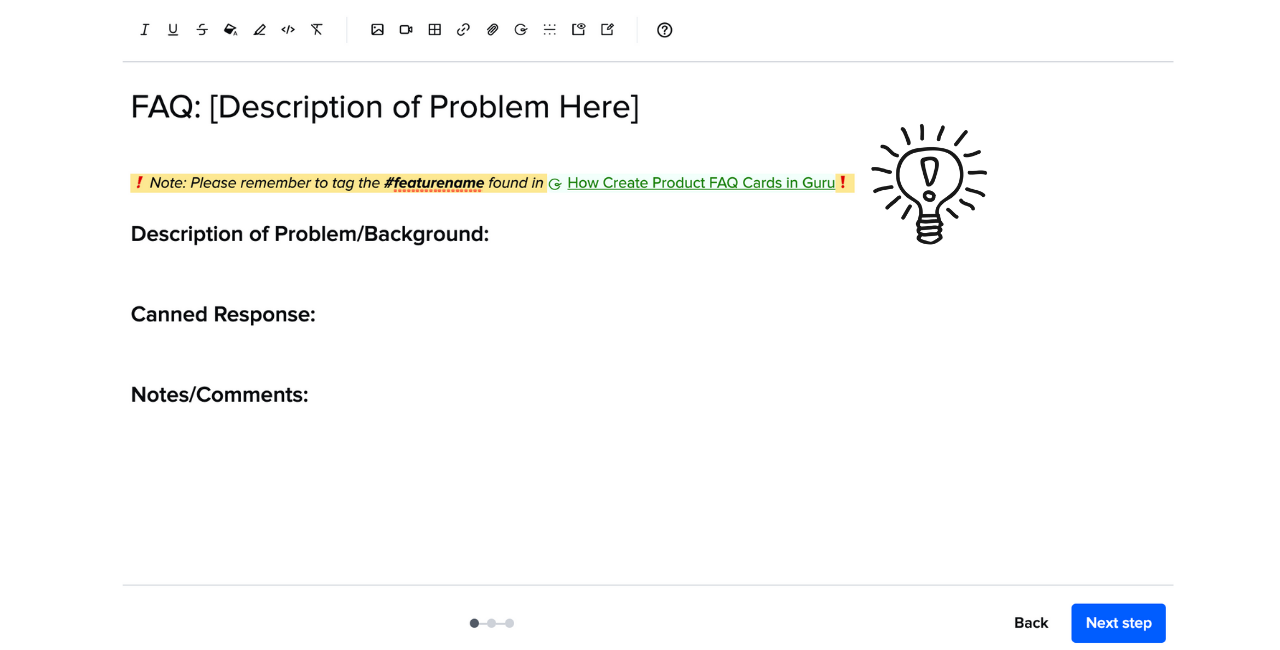📘 Best Practices: Tags
Follow these instructions to create a tagging strategy that will help your team adopt and leverage tags effectively.
Access RequiredAs a Guru workspace Admin, you can add tags to any Card. As a Collection Owner or a relevant custom role, you can only add tags to Cards that are in Collections to which you have access.
1. Select "Collection champs" for each Collection
Teamwork makes the dream work! ✨ The more users invested in the Knowledge Philosophy of Guru, the easier it will be to create and maintain a knowledge-driven culture that increases user adoption, team engagement, and the verification score of your knowledge base.
These users can be the Collection owner or subject matter experts of your Collections, managers of your team, or just Guru-enthusiasts who are on a mission to help make your knowledge in Guru as best as it can be! Have these users ready and on deck to mobilize change throughout the process.
2. Pull together a list of all possible tags
This is the time to think big-picture and envision what tags will connect your Guru knowledge with the keywords your team is searching for. These are the tags that users from all different departments will need at their disposal, which is why we call them your ALL team tags.
Create a Guru Card to write all your tags down or use our Tag Structure Worksheet to help you stay organized as you brainstorm your taxonomy.
Don't worry if this is not your perfect, end-all list of all tags that will ever live in your Guru workspace. Your knowledge base will grow and evolve, and you can always refine this list of tags at a future date.
Examples of possible sources of tags
- Tags for your personas and use cases
- Tags for each feature or product in your catalog
- Tags for company goals or metric
3. Create "Tag Categories" and populate your tags
Now it's time to move to tag management! 🚀 Create a tag category where tags will be grouped around a certain subject matter area:

4. Meet with your designated "Collection champs" to discuss tags
Meet with your designated Collection champs to help you create a list of tags specific to their Collection or department in a Guru Card.
- These are the tags that are owned by the primary contributors of this Collection. For instance, the marketing team might create tags for #Blog or #CompetitiveBattleCard since these types of Cards are created by contributors in the "Marketing" team's Collection.
- Once you have your list of tags specific to a department or Collection, organize this list into different topics, groups, etc. Now, create a new tag category within Settings > Tag Management and title it "[NAME OF COLLECTION/TEAM] team tags".
TipRefer to existing Collection and folder titles and even the titles of existing Cards to help create tags related to broader topics in your Collection. Then, drill-down to create more specific tags that can be layered on these tags.
5. Build a team tag architecture to bring all the tags together
Now that you have created tag categories for all tags and for your Collection or specific departments, it's time to bring all the pieces together.
- To help you visualize this architecture, open Settings > Tag Management for an overview of all tags you've created and to picture all of the tag Categories as parts of a car.
- Your "all" team tags are the hood and carriage of your car. Just like how the hood and carriage are visible to everyone who looks at your car, these are the tags that are most visible and most used by your team as a whole.
- The "[Collection/Name of Team] team tags" are all of the other parts of the car. Each part has a specific function and purpose for how it is used. These tags are less visible to the broader team's eye. They are tags that should be used by each team to surface knowledge that is most relevant to their role, materials, and processes in their day-to-day workflow.
Just like you can teach someone to drive a stick shift, you can also teach other departments how to use some of the tags in your team tags category that are most relevant to them.
6. Re-tag existing knowledge using your new tags
Tag, you're it! 🏃♀️With your tool belt of tags assembled and Collection champs by your side, it's time to tag any existing knowledge using your tag structure as your guide. Re-tag the Collection by either navigating through each Card on your folders or utilizing Card Manager to tag Cards quickly by using Guru's bulk tag action.
- We advise dividing and conquering this project by designating specific folders for your Collection champs to tackle and tag.
- As you work through tagging the Collections, make a note of any additional tags you may want to add to the Team-specific tags or all team tag categories. This is great to find any tags you might have overlooked!
- Once you are finished tagging a Collection, give yourself and your Collection champs a virtual high-five 🤚for doing an awesome job.

7. Educate the broader team on how to use tags
Share the wisdom to help your team! 🤓 Now that your Collection or Collections are tagged in adherence to your shiny new tag structure, it's time to educate the broader group on how to use them to both search and create Cards.
For Search:
- Create a Card for "How to Search [BLANK] Collection" and include a list of the tags most relevant to each team and how they can use them.
- Send an announcement on this Card and make sure to point out what tags are in the "all team tags" list and which tags are in the specific department tag categories relevant to them.
For Card creation:
- Create Card templates for your contributors to use to speed up the process of contributing knowledge to their Collections. In the Card template, assign auto-tags that are relevant to each type of Card.

Tips
Create a note at the top of the Card reminding contributors to tag the Card following the tag structure and link out to the Card you created for "How to Search [BLANK] Collection".
Any tags with an underscore (ex: Guru_Card) will not surface Cards with that tag when searched as a term. If a tag has an underscore, Cards with that tag will only surface when the tag is searched as a tag.
8. Create a tag maintenance cadence and check-in
To make sure the tag structure aligns with your team's knowledge philosophy, you need to monitor, audit, and create new tags as your knowledge in Guru grows and evolves.
We suggest creating a cadence with your Collection champs to conduct a Guru audit and tag maintenance session.
Choose a meeting interval that meets the needs of your knowledge base. Some teams do bi-weekly sessions (1 hour each), while others opt for a monthly meeting for 2 hours.
We've seen teams get creative and have a virtual "tagging party" with music to make these sessions engaging for those who volunteered to help. Two, three, or four sets of hands are better than one in building a long-lasting and fruitful knowledge base. 💫
Want a closer look at some key Guru features and best practices?Check out our events page for demos, workshops, new release roundups, Getting Started bootcamp, guest panelists and more! For upcoming live events and a series of past recordings: Click here to register
Updated 5 months ago
